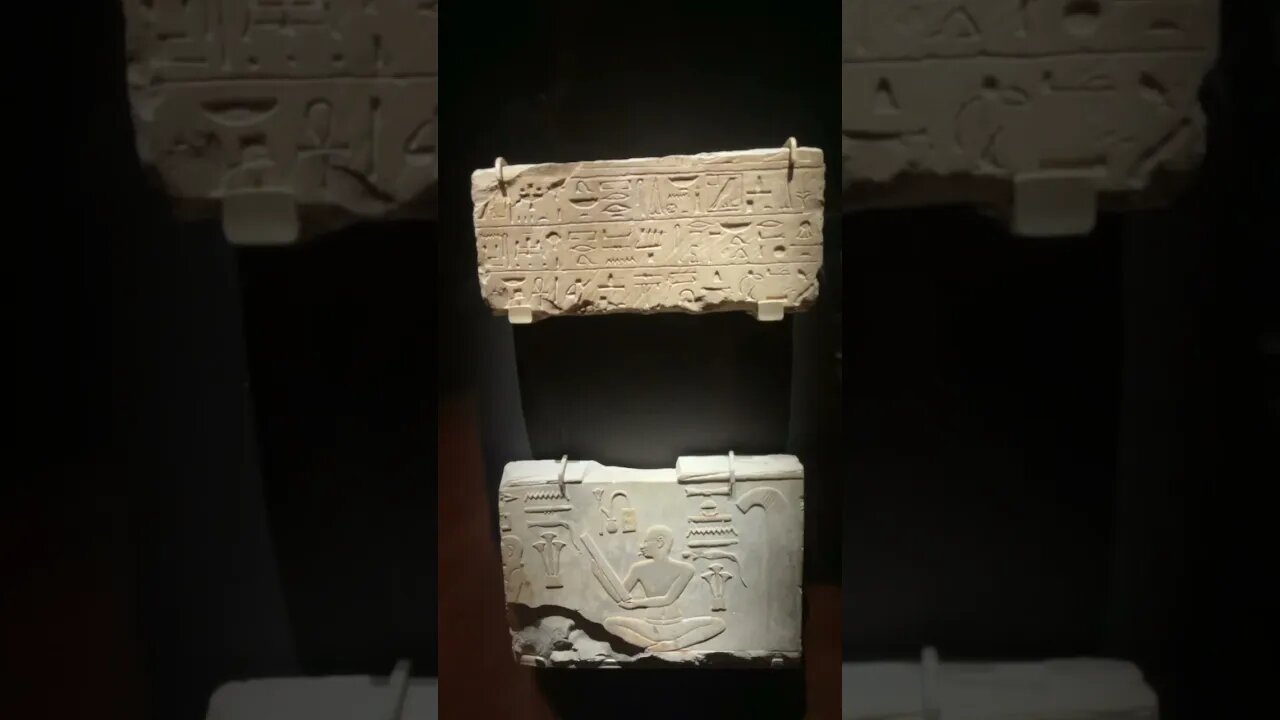Premium Only Content

아문호테프 1세, 민호테프의 석비, 이집트, 신왕국, Amunhotep I, Ahmose-Nofretary before Osiris, 석회암, 테베, 스핑크스, 피라미드, 파라오
Amenhotep I (sometimes read as Amenophis I and meaning "Amun is satisfied") was the second Pharaoh of the 18th dynasty of Egypt. His reign is generally dated from 1526 to 1506 B.C.E.. He was born to Ahmose I and Ahmose-Nefertari, but had at least two elder brothers, Ahmose-ankh and Ahmose Sapair, and was not expected to inherit the throne. However, sometime in the eight years between Ahmose I's 17th regnal year and his death, his heir apparent died and Amenhotep became crown prince. He then acceded to the throne and ruled for about 21 years.
Although his reign is poorly documented, it is possible to piece together a basic history from available evidence. He inherited the kingdom formed by his father's military conquests and maintained dominance over Nubia and the Nile Delta, but probably did not attempt to keep power in Syrio-Palestine. He continued to rebuild temples in Upper Egypt, and revolutionized mortuary complex design by separating his tomb from his mortuary temple, setting a trend which would persist throughout the New Kingdom. After his death, he was deified into the patron god of Deir el-Medina.
Family
Amenhotep I was the son of Ahmose I and Ahmose-Nefertari. His elder brothers, the crown prince Ahmose Sapair and Ahmose-ankh, died before him, thus clearing the way for his ascension to the throne.[3][4] Amenhotep I probably came to power while he was still young himself, and his mother, Ahmose-Nefertari, appears to have been regent for him for at least a short time.[5] This is evidenced because both he and his mother are credited with opening a worker village at the site of Deir el-Medina.[5] Amenhotep took for his Great Royal Wife, Ahmose-Meritamon, his sister.[6] Another wife's name, Sitkamose, is attested on a nineteenth dynasty stele.[7]
Beyond this, his relation to all other possible family members has been questioned. Ahhotep II is usually called his wife and sister,[6] despite an alternate theory that she was his grandmother.[7] He is thought to have had one son by Ahhotep II, Amenemhat, who died while still very young.[6] This remains the consensus, although there are arguments against that relationship as well.[7] With no living heirs, Amenhotep was succeeded by Thutmose I, whom he married to his sister, Aahmes,[6] although once again there is no definite proof that the two were related. Since Aahmes is never called "King's Daughter" in any inscription, some scholars doubt this relation as well.[7]
Dates and length of reign
In the ninth year of Amenhotep I, a heliacal rise of Sothis was observed on the ninth day of the third month of summer.[8] Modern astronomers have calculated that, if the observation was made from Memphis or Heliopolis, such an observation could only have been made on that day in 1537 B.C.E. If the observation was made in Thebes, however, it could only have taken place in 1517.[9] The latter choice is usually accepted as correct since Thebes was the capitol of early 18th dynasty Egypt; hence, Amenhotep I is given an accession date in 1526 B.C.E.,[8] although the possibility of 1546 B.C.E. is not entirely dismissed.
Manetho's Epitome states that Amenhotep I ruled Egypt for 20 Years and 7 Months or 21 Years,[1] depending on the source.[10] While Amenhotep I's highest attested official date is only his Year 10, Manetho's data is confirmed by information from a passage in the tomb autobiography of a Magician named Amenemhet. This individual explicitly states that he served under Amenhotep I for 21 Years.[11] Thus, in the high chronology, Amenhotep I is given a reign from around 1546 to 1526 B.C.E. and, in the low chronology, from around 1526 to 1506 B.C.E. or 1525 to 1504 B.C.E.,[12] though individual scholars may vary by a few years.
Foreign policy
Relief of Amenhotep I from Karnak.
Amenhotep I's Horus and Two Ladies names, "Bull who conquers the lands" and "He who inspires great terror," are generally interpreted to mean that Amenhotep I intended upon dominating the surrounding nations.[8] Two tomb texts indicate that he led campaigns into Nubia. According to the tomb texts of Ahmose, son of Ebana, Amenhotep later sought to expand Egypt's border southward into Nubia and he led an invasion force which defeated the Nubian army.[13] The tomb biography of Ahmose Pen-Nekhebet says he also fought in a campaign in Kush,[14] however it is quite possible that it refers to the same campaign as Ahmose, son of Ebana.[8] Amenhotep built a temple at Saï, showing that he had established Egyptian settlements almost as far as the third cataract.[5]
A single reference in the tomb of Ahmose Pen-Nekhebet indicates another campaign in Iamu in the land of Kehek.[15] Unfortunately, the location of Kehek is unknown. It was long believed that Kehek was a reference to the Libyan tribe, Qeheq, and thus it was postulated that invaders from Libya took advantage of the death of Ahmose to move into the western Nile Delta.[
-
 LIVE
LIVE
Sarah Westall
2 hours agoRead the Signs: Are We Already Operating in a New Financial System? w/ Andy Schectman
256 watching -
 LIVE
LIVE
SpartakusLIVE
2 hours agoNEW Update - BROKEN Attachment || Viewers REJOICE at the long-awaited Return of Their KING
498 watching -
 1:14:07
1:14:07
Glenn Greenwald
6 hours agoGlenn Takes Your Questions: Billionaires, Bari Weiss and Journalism | SYSTEM UPDATE #509
45.9K20 -
 LIVE
LIVE
StevieTLIVE
1 hour agoFriday Night HYPE Warzone Games with Stevie
93 watching -
 LIVE
LIVE
SavageJayGatsby
21 hours agoLet's Play: Sea of Thieves | Friend Friday
83 watching -
 LIVE
LIVE
GritsGG
1 hour agoTop 250 Ranked Grind! Dubulars!🫡
78 watching -
 19:51
19:51
Robbi On The Record
22 hours agoElectronic Tattoos Measuring Thoughts? From iPhone to iSkin
11.6K15 -
 8:12
8:12
Hollywood Exposed
1 day agoJoy Behar Tried To Shame Tulsi Gabbard And Instantly FAILED
171 -
 17:03
17:03
IsaacButterfield
16 hours ago $0.12 earnedBritish Man ARRESTED for Saying ‘I Love Bacon’ to a Muslim!!
8833 -
 LIVE
LIVE
The Sufari Hub
2 hours ago🔴SUFARI & JAMES TAKE ON THE UNDEAD - DYING LIGHT THEN THE FOLLOWING
12 watching